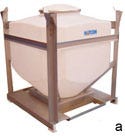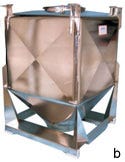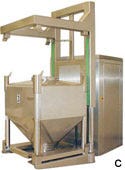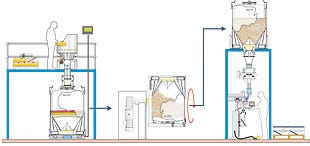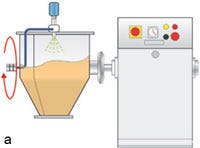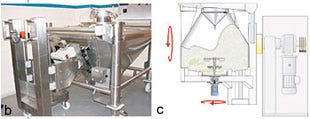Developments in Containerized IBC Blending
January 11, 2007
|
|
|
Mixing and Blending options: |
|
Typical parallel process with IBC blending |
Mixing and blending are key process steps in most industries that handle and process powders in their manufacture of their products. These process steps are used either for premixes or finished products in the pharmaceutical, food, metal powder, chemical, and plastics industries.
In recent years, more and more processors have introduced homogeneous in-bin tumble blending, in which the container or intermediate bulk container (IBC) used for interprocess material handling also acts as the mixing and blending vessel. This method greatly reduces the downtime required to perform cleaning steps associated with ribbon mixers, allowing another IBC to be filled with ingredients and blended immediately.
|
Another benefit of IBC blending is that it eliminates the need for powder transfer to and from the blender, reducing the risk of escaping dust caused by unnecessary transfers and eliminating the risk of segregation during mixer discharge. An IBC containing formulated ingredients is simply loaded into the blender and tumbled at a given duration and speed to achieve suitably blended material. After blending, the IBC is either stored for future processing, taken directly to the next process step, or packed.
Recent technologies offer producers many advantages, including improved production flexibility and efficiency resulting from the decoupling of the formulation-mixing-packing process chain. These technologies also improve product quality greatly, leading to cleaner production facilities, the elimination of cross-product contamination, and minimal cleaning.
|
Blending innovations: (a) liquid addition during blending, (b) IBC with infrared analysis, (c) IBC blender with shear |
IBC blending has generally been used solely for dry powders. Until recently, it was never used when either shear or liquid additions were required by the process or formulation. However, modern IBC blending has introduced such technologies. Blenders can incorporate electric or air-driven motors that are mounted on the blender cage and directly coupled to mixing blades in the IBC. In addition, blenders with attachments enable the addition of liquids during the blending process.
Another development is that blenders can now be equipped with analytical devices to assist in material validations. Such devices indicate whether materials have been blended adequately without manufacturers having to resort to manual inspections. Analytical techniques include process analytical technology, infrared spectrum analysis, and effusivity thermal sensors, which allow clients to monitor and report on the quality and homogeneity of their products during the blending process.
For further information, call 866-962-8266 or visit www.matconibc.com.
Tony Parsloe is business development manager at Matcon USA Inc., Sewell, NJ. Matcon specializes in providing solutions for handling powders, granules, tablets, and other materials in IBCs. Parsloe can be reached at 856-256-1330 or [email protected].
You May Also Like
